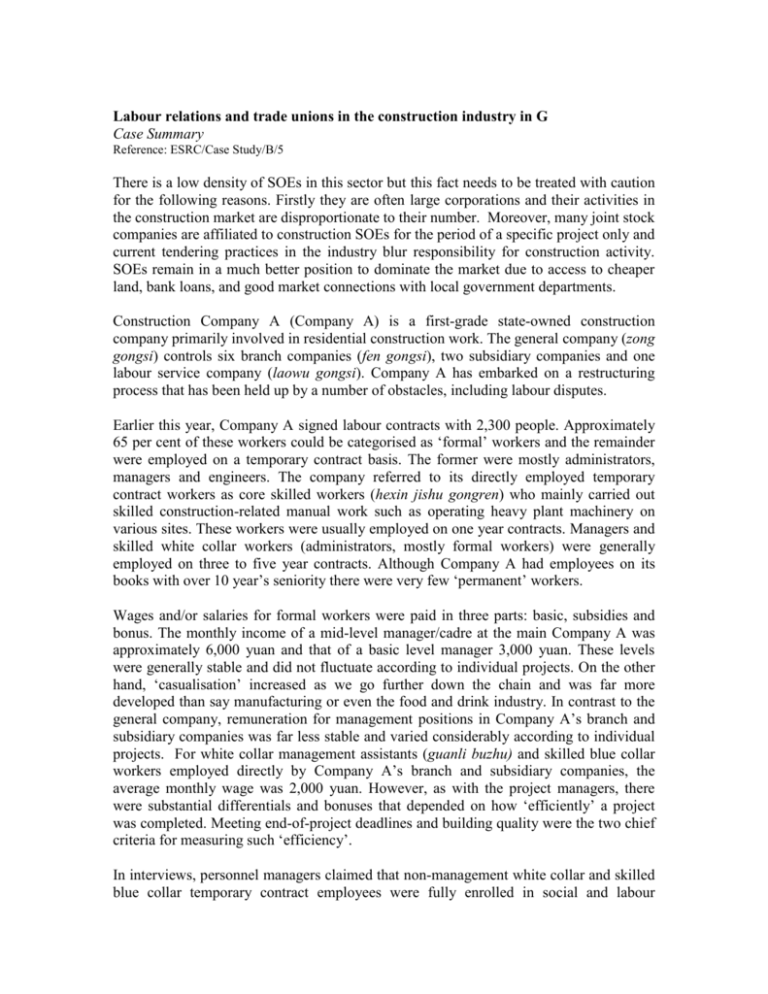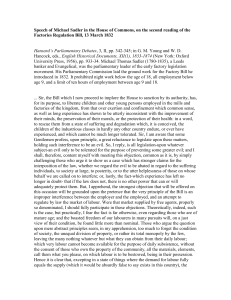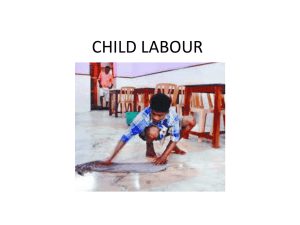Extract from Construction Paper
advertisement

Labour relations and trade unions in the construction industry in G Case Summary Reference: ESRC/Case Study/B/5 There is a low density of SOEs in this sector but this fact needs to be treated with caution for the following reasons. Firstly they are often large corporations and their activities in the construction market are disproportionate to their number. Moreover, many joint stock companies are affiliated to construction SOEs for the period of a specific project only and current tendering practices in the industry blur responsibility for construction activity. SOEs remain in a much better position to dominate the market due to access to cheaper land, bank loans, and good market connections with local government departments. Construction Company A (Company A) is a first-grade state-owned construction company primarily involved in residential construction work. The general company (zong gongsi) controls six branch companies (fen gongsi), two subsidiary companies and one labour service company (laowu gongsi). Company A has embarked on a restructuring process that has been held up by a number of obstacles, including labour disputes. Earlier this year, Company A signed labour contracts with 2,300 people. Approximately 65 per cent of these workers could be categorised as ‘formal’ workers and the remainder were employed on a temporary contract basis. The former were mostly administrators, managers and engineers. The company referred to its directly employed temporary contract workers as core skilled workers (hexin jishu gongren) who mainly carried out skilled construction-related manual work such as operating heavy plant machinery on various sites. These workers were usually employed on one year contracts. Managers and skilled white collar workers (administrators, mostly formal workers) were generally employed on three to five year contracts. Although Company A had employees on its books with over 10 year’s seniority there were very few ‘permanent’ workers. Wages and/or salaries for formal workers were paid in three parts: basic, subsidies and bonus. The monthly income of a mid-level manager/cadre at the main Company A was approximately 6,000 yuan and that of a basic level manager 3,000 yuan. These levels were generally stable and did not fluctuate according to individual projects. On the other hand, ‘casualisation’ increased as we go further down the chain and was far more developed than say manufacturing or even the food and drink industry. In contrast to the general company, remuneration for management positions in Company A’s branch and subsidiary companies was far less stable and varied considerably according to individual projects. For white collar management assistants (guanli buzhu) and skilled blue collar workers employed directly by Company A’s branch and subsidiary companies, the average monthly wage was 2,000 yuan. However, as with the project managers, there were substantial differentials and bonuses that depended on how ‘efficiently’ a project was completed. Meeting end-of-project deadlines and building quality were the two chief criteria for measuring such ‘efficiency’. In interviews, personnel managers claimed that non-management white collar and skilled blue collar temporary contract employees were fully enrolled in social and labour insurance schemes as stipulated in the Labour Law, although some workers stated in private that they were only covered by schemes relating to pensions, unemployment and work injury compensation but not medical or maternity insurance Reflecting confusion and anomalies in the overall reform of labour insurance as well as management deliberate obfuscations, researchers found particular difficulty in ascertaining exactly which social insurance schemes manual temporary workers were covered by, if any at all. This was a reflection of the ‘casualisation’ in employment even at this comparatively stable level of temporary contracts for skilled workers in a nominally state owned construction company that traditionally offered more established jobs than those available in the private sector. Well over 80 per cent of the construction workers working on Company A’s sites were off-farm migrant workers employed on two different types of construction projects. The first category was self-operated projects (zi ying xiangmu) in which Company A or one of its branch or sister companies successfully bid for contracts in their own name and directly organised construction work on the projects it won as a result. Although labour relations on these sites were comparatively stable, all the actual work processes were subcontracted out by Company A and very few of the migrant workers employed on site were in a direct labour relationship with Company A itself. Company A also entered into ‘commercial alliances’ with other companies in order to bid for contracts. In this scenario, Company A remained nominally in charge of the project but in actual fact had no direct connection with its organisation or completion. In arrangements of this sort, Company A retained a supervisory role with regard to onsite safety and quality as well as a default responsibility to insist on the partner company’s adherence to various rules and regulations relating to construction. However, Company A took no responsibility for any loss or profits made on the project or indeed the overall quality of the finished product. In this type of arrangement, it is especially hard for workers to pursue their rights and interests through legal means. Site workers often do not know the name of the company managing the site and thus lack a target to pursue and negotiate should the gang master run short of funds to pay them. Even when government departments such as the MOLSS intervene in such disputes, their capacity to solve them was limited for the same reason. In one dispute, 40 migrant workers came to the office, angrily surrounded project manager L, and refused to leave until funds had been allocated to cover their unpaid wages. In fear of his safety, L called the police as well as local neighbourhood officials who duly stipulated that both sides negotiate a settlement. The seriousness of the incident was further demonstrated by the arrival of a senior deputy general manager from Company A as well as the chair person of Company A trade union. An official from the labour inspectorate of the local MOLSS also arrived to mediate the ensuing negotiations. Company A’s position in the dispute was largely determined by its aim of avoiding an escalation. The deputy manager pointed out that while they were responsible for the overall project, the work of installing glass walls and windows had been subcontracted to Company B. According to the contract between companies A and B, the latter would only begin to receive payments for the work from Company A after it was at least 50 per cent complete. Payments would be made in accordance with a schedule written into the contract. Company A’s manager stated that the company had remained within the terms of the contract and that they could not be held responsible for the workers’ wages. The official from the labour inspectorate immediately contacted Company B and requested that a representative be sent to attend the negotiations. The remaining protesting workers waited outside the office. Company B’s ‘representative’ duly arrived and negotiations – which continued for five hours – began. They were chaired by the labour inspectorate official. Taking part were: four workers’ representatives, Company B’s representative, the deputy general manager from Company A, and the trade union chair from Company A. The process started with the four workers’ representatives providing evidence that they had completed the work and were owed money. Company A’s deputy general manager restated his company’s position outlined above. The ‘representative’ from Company B – who later stated that he himself was a subcontractor and had obtained the work from Company B – disagreed with Company A’s position on two counts: Firstly that because the project had overrun costs, the funds issued by Company A to Company B had been insufficient; and secondly that the protesting workers themselves had been hired by a gang master (Z) who had originally agreed to complete installation work and, as with the contract between A and B companies, should not receive full payment – from Company B – until the agreed ratio of the work had been completed. Company B’s representative then produced written proof that it had already released 1.2 million yuan to Z and that this money was enough to cover wages for the work completed. In his view, Z – and his workers – had no legitimate grounds to demand money off Company B. Moreover, Company B’s representative argued that any portion remaining unpaid to Z was on account of poor work that required redoing. According to the contract, Z should be paying compensation to Company B for the losses they had incurred. Company A’s deputy general manager responded by arguing that a final budget could not be predicted while the project remain unfinished and as such it could not be said to have ‘overrun’ budget at this stage. Moreover, it had paid over funds to Company B on schedule and had no obligation whatsoever to the workers, even if they had been not been paid in full. The position of the workers’ representatives hardened. According to their explanation, Z had used the 1.2 million yuan released by Company B to purchase building materials and was now owed 750,000 yuan. He had since disappeared and as far as they were concerned, they needed their wages in order to return home for Lunar New Year. The reps said that they did not care whether the cash came from Company A or Company B. The officials from the MOLSS’s local labour bureau and the neighbourhood committee repeatedly tried to persuade the workers to calm down and promised to help them achieve their objectives in a reconvened meeting the following day. However, the workers refused to leave without the money owed. At this point Company A’s deputy manager – who had been under pressure from the labour inspectorate to compromise – announced that as long as the exact figure owed could be confirmed and that this figure did not exceed the overall budget stated in the contract, his company would take responsibility for the debt. Once this promise had been made, the workers agreed to reconvene the next day in order to collect their money. Company A’s deputy manager later conjectured that the entire incident had been a joint effort planned by the gang master Z, the B company representative and the workers in order to force his company into a corner and offer a compromise..








